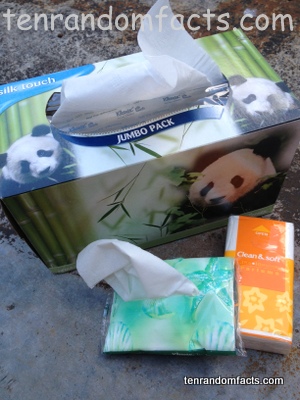Achoo! At least I have a facial tissue.
- ‘Facial tissues’ are also known as ‘paper handkerchiefs’, ‘tissues’, ‘paper tissues’ and ‘Kleenex’, after a popular brand name.
- Facial tissues are soft, lightweight disposable paper used for the face, typically to blow one’s nose.
- Facial tissues act as a replacement of a handkerchief and have the advantage of being disposable, rather than needing washing, and are said to be more hygienic as the used cloths are not left in pockets.
- Facial tissues are usually made totally of pulp from wood chips and chemicals that break the chips down.
- People of Japan have used facial tissues for centuries, although Europeans first discovered the practice on a 17th century voyage.
- Kimberly-Clark Corporation invented modern facial tissues in 1924, calling them ‘Kleenex’, made for the purpose of removing makeup or cold cream.
- Facial tissues can be printed, scented, covered with special lotions, and can be single, double or triple ply.
- In 1926, a survey was conducted on the use of Kleenex facial tissue, and it was discovered that 60% of people were using the tissue to blow their nose, so Kimberly-Clark changed the way they marketed the product.
- Facial tissues can be a flushable substitute of toilet paper or as a disposable substitute of a wiping cloth and can have various other uses around the home.
- Facial tissues vary in size, from small to large, generally depending on the box the tissues are stored in, although a single tissue is generally palm or pocket sized.






Thank Cris for the nice article. In my kitchen paper towels are using and for living areas, I am using Facial Tissues. The facial tissue is very useful to blow the nose, which is cheaper and softer.